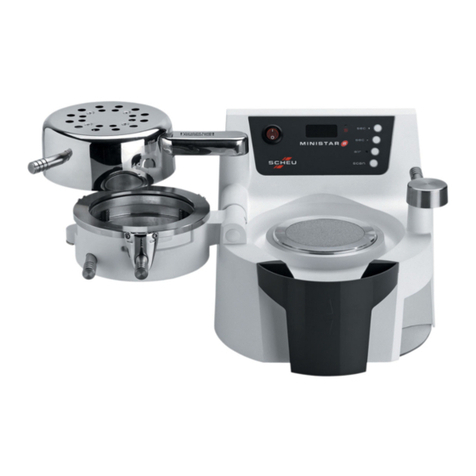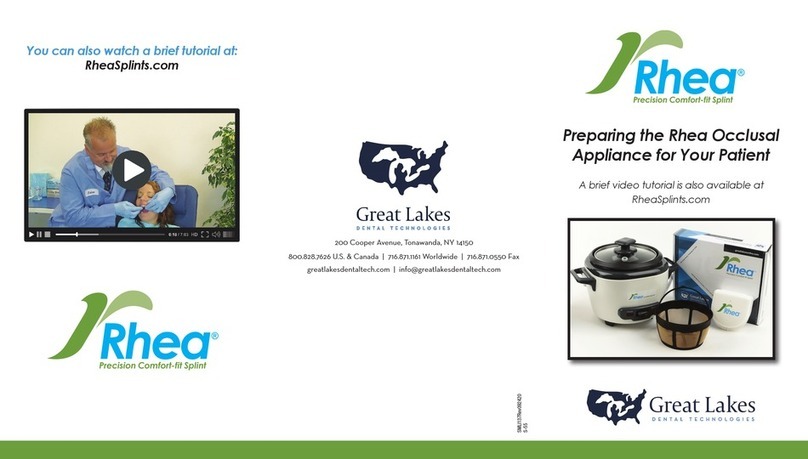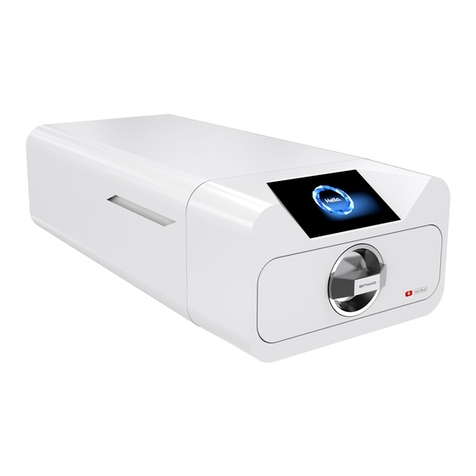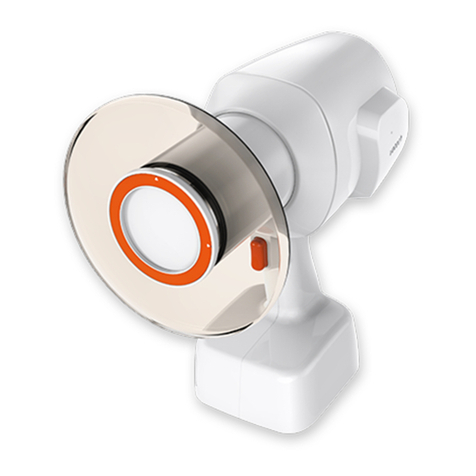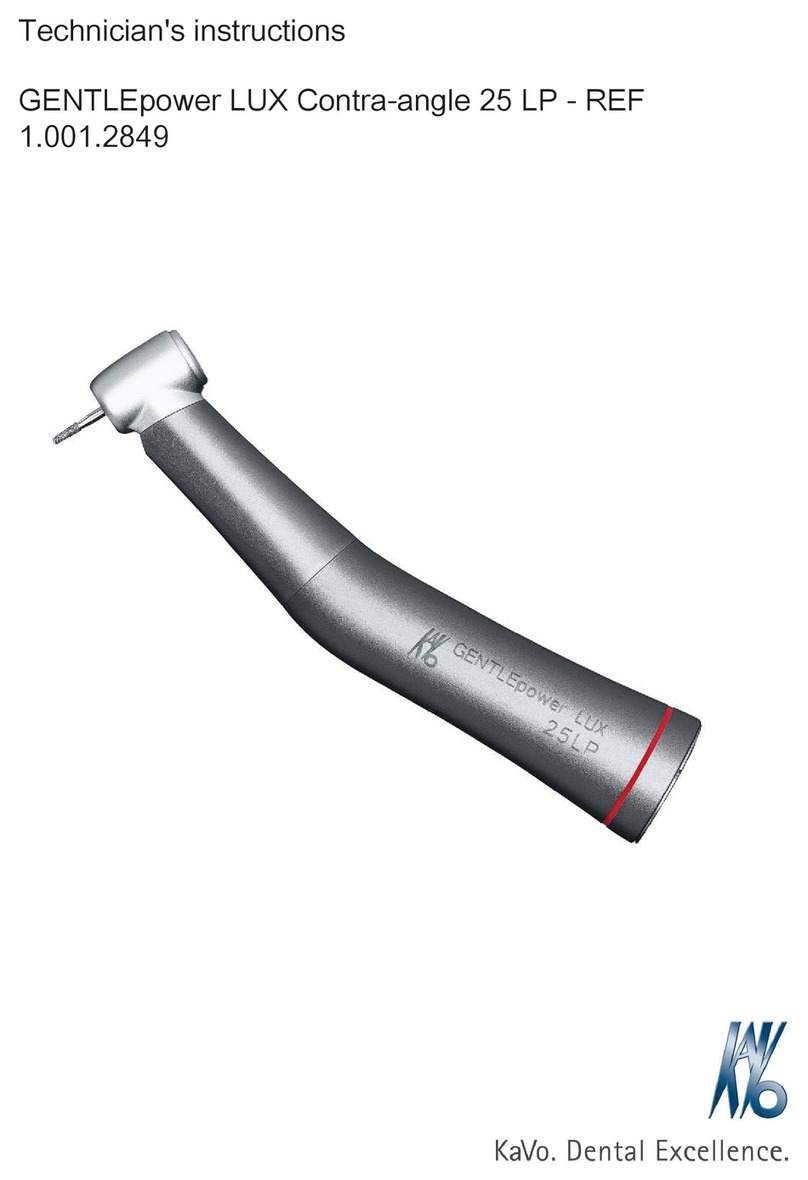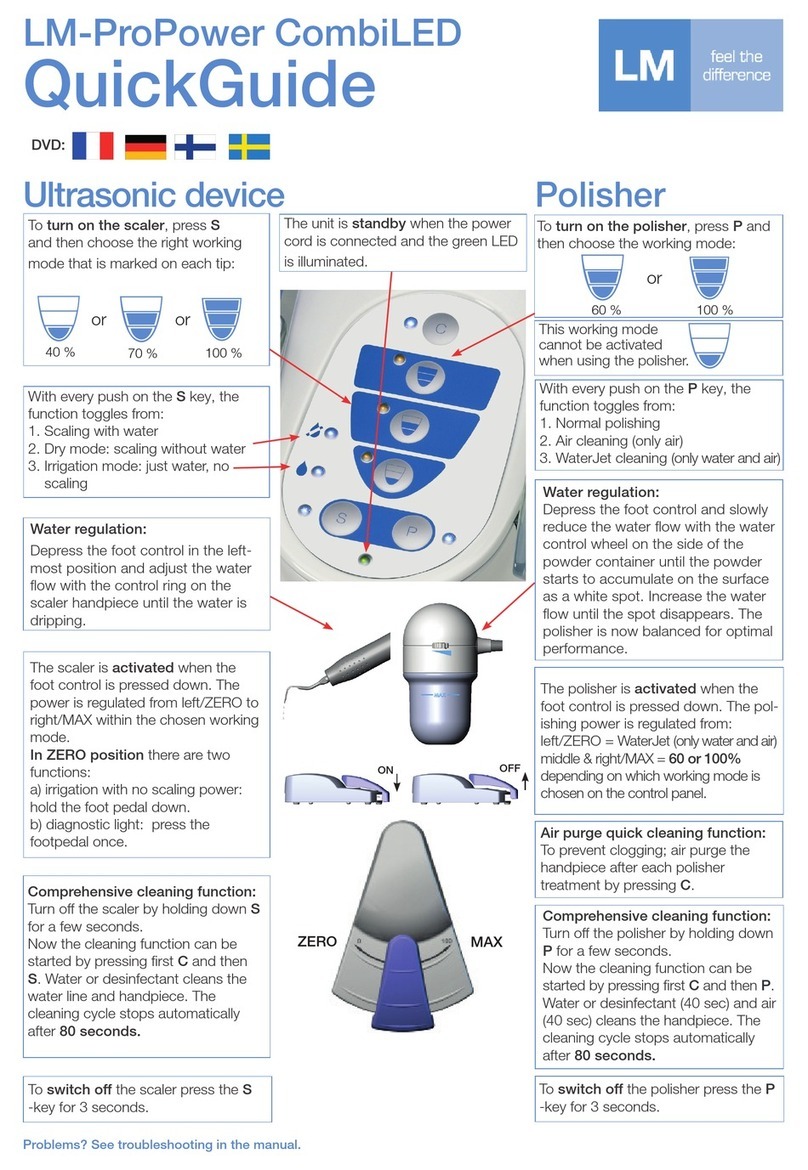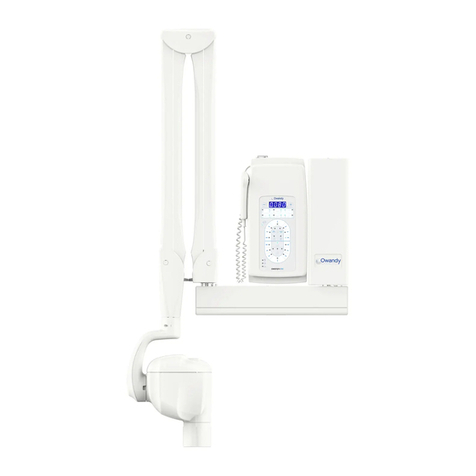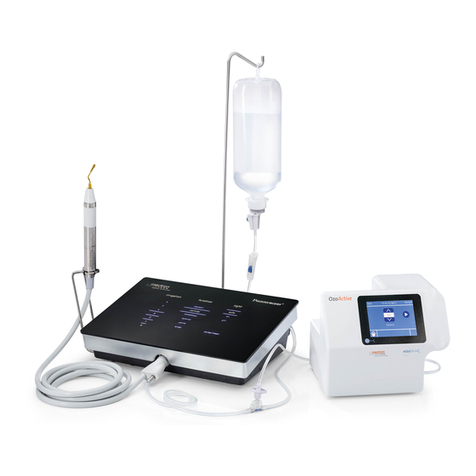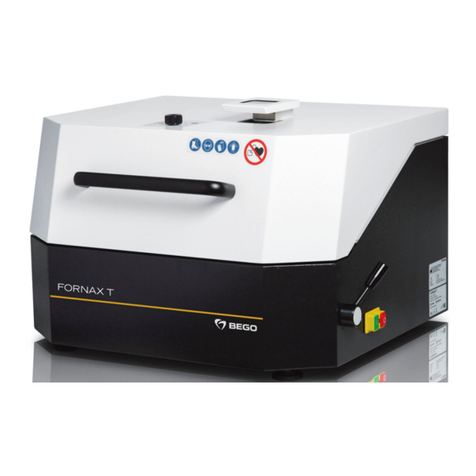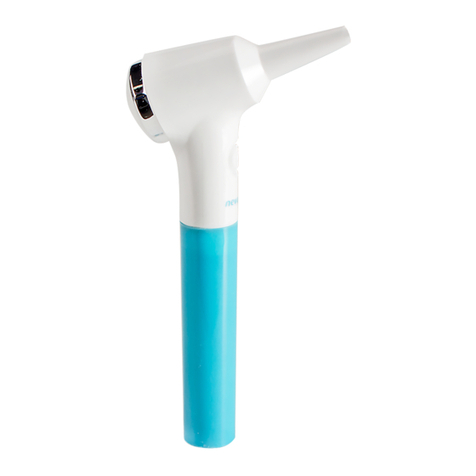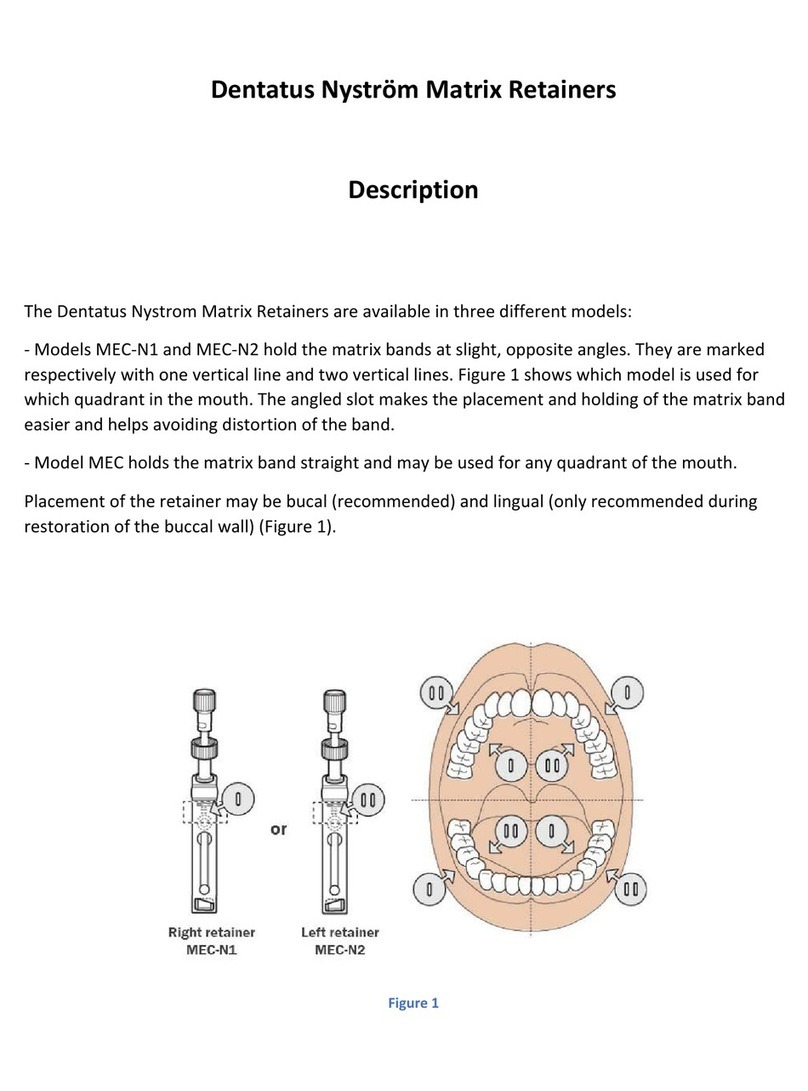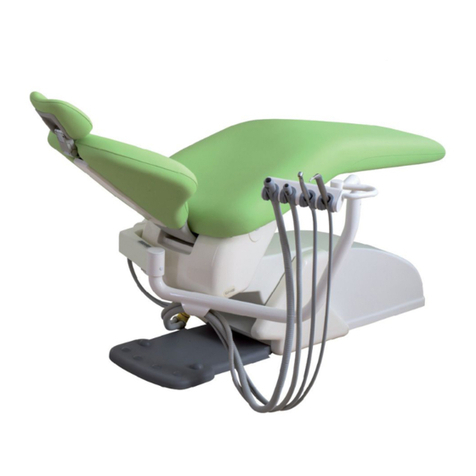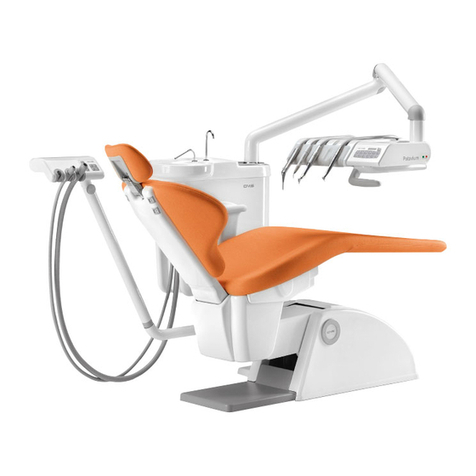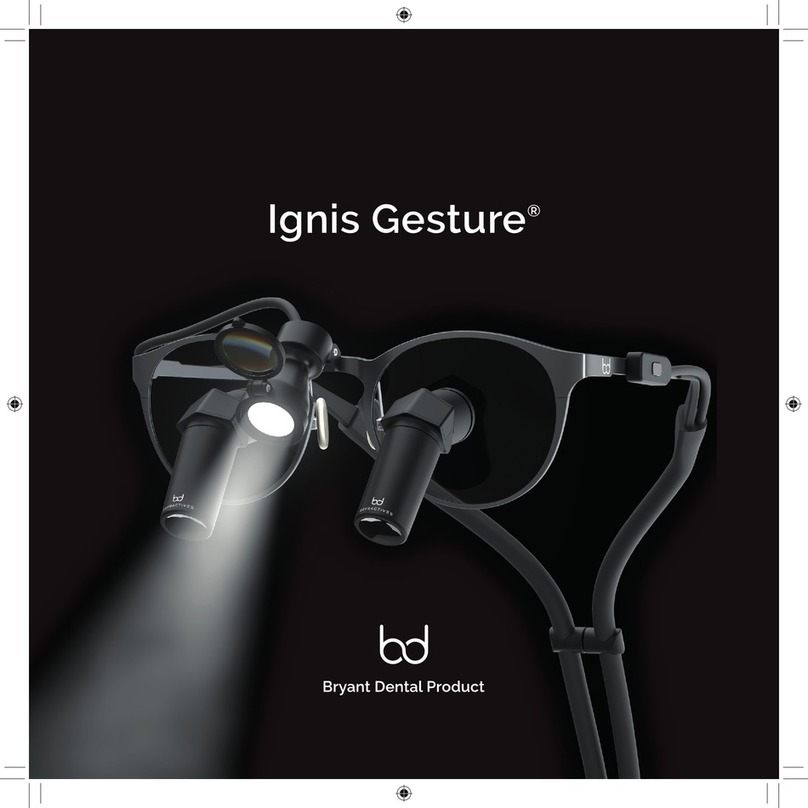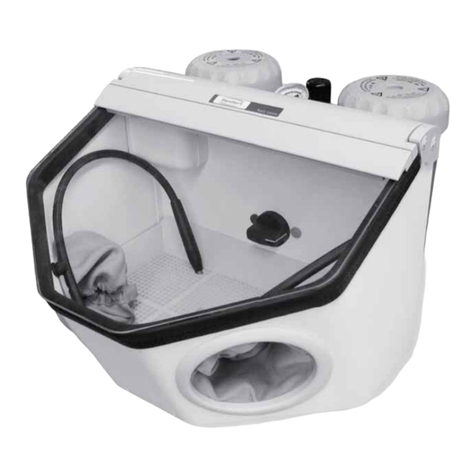Great Lakes Biostar Scan User manual

Biostar®Scan/Biostar®V
Operation Manual
200 Cooper Avenue, Tonawanda, NY 14150
greatlakesdentaltech.com | 800.828.7626

Biostar®
The computerized Biostar pressure molding machine features modern micro processing
electronics designed to improve the ease of operation and thermal forming results.
Installation
Before removing the machine and its components from the shipping box, determine the
location for the Biostar in the laboratory. The machine’s size and weight are outlined on page
3. Make sure sufcient workspace around the machine is available and that nothing will
interfere with operation of the heating element. Reminder: Keep any ammable material
away from the heating element.
As you unpack the contents of the shipping box, you will nd the following:
• Biostar unit
• Pellet Drawer
• Pellet/model cup
• Clamping frame
• Model platform
• High pressure hose, hose clamps, and air lter
• Hose clamps
• Container of pellets
• Pellet brush
1

Heating Element: Found on left side of
machine, swivels from front to back and is used
to soften thermal-plastics.
Pressure Chamber: Compartment that the
thermal-plastic material is held, heated, and
formed over a dental model.
Locking Handle: Holds chamber in molding
position and allows air pressure to enter
chamber.
Clamping Frame: Secures thermal-plastic to
chamber.
Pellet Drawer: Contains overow of pellets.
Bar Code Scanner: Automatically enters the correct
processing information for the thermal-plastic.
Plug with Fuse: Built-in plug with a two 8-amp
fuse compartment.
Pressure Controller: Air pressure adjustment
dial to control the amount of pressure that is
used within the Biostar.
Compressed-air Connection: Connects to
laboratory air pressure source.
On/Off Switch: Power switch.
Code Button: Programs heating and cooling
operating times for material heating and
pressure forming.
Air Button: Removes air pressure from
chamber.
CE Button: Erases information placed in
memory.
Time Button: (Illustration of clock) Allows
operator to manually program heating and
pressure molding times, separately.
After inspecting the items, remove all packing material, and position the Biostar unit on the
laboratory bench. To prevent machine malfunctions as a result of excessive dust, do not place
the unit near etcher catchers, micro etchers, or any area where extensive plasterwork will
occur. The air source should be within reach of the machine using the high-pressure hose as a
reference guide. Do not place the pressure line under the heater along the benchtop. The air
pressure should be capable of supplying a minimum of 87 psi. to the Biostar.
The following information provides a brief description of the computerized Biostar’s basic
components.
2
plug with fuse
compressed-air connection
pressure controller (regulator)
Heater
Locking Handle
Clamping Chamber
Pressure Chamber
Bar Code Scanner
Pellet Drawer

3
CODE: Three-digit code to identify heating
and pressure molding times.
(t): Heating Time: Time that material is to be
heated.
TEMP: Actual Temperature: Actual
temperature of the heating lamp. (Ts) and (T)
should be equal prior to operation.
(P): Pressure: Operating air pressure. Appears
on screen every 10 seconds. Measurement in
bar (1 bar approx. 15 psi).
A – Platform: Circular plate that is placed on
the inner lip of the pellet cup.
B – Pellet Cup: Container that holds dental
model, pellets, and platform for the pressure
forming process.
C – Clamping Frame: Secures thermal-plastic
to chamber.
Technical Data:
Voltage 110/220 V – 50/60 Hz
Power Maximum 850 W
Work Pressure Max 6 bar/87 psi
W x D x H 18”x 10”x 10.25”
Weight 35 lbs./16 kg
Fuse (Two) 5x20mm 10 amp fuse
A
B
C

4
1. Plug one side of the electrical cord in the back
of the Biostar and the opposite end into a
three prong 110v outlet.
2. Connect the Biostar to the air source using the
high-pressure hose. Secure it in place with a
hose clamp.
Note: Route the electrical cord and pressure
hose away from the heating element.
3. The pellet cup (C) is positioned on the four
blocks of the Biostar table (A). Fill halfway
with pellets.
4. Place platform (B) onto the inner cup lip of the
pellet cup.
5. Pour pellets to half-ll the pellet drawer (D).
Slide drawer into compartment located at the
front of the machine.
6. Working pressure of 6 bar (90psi) is pre-
set in the machine. With the machine in the
“on” position, press the “CODE” button.
The current unit pressure will show on the
display. Reach behind the machine and pull
out the regulator dial and turn clockwise to
raise the pressure and counter-clockwise to
lower the pressure. The display will show the
change in pressure. When the desired pressure
is reached, push the regulator dial back into
place.
Note: Maximum pressure can only equal what
the main line is capable of supplying.
A
B
C

Reminder: Do not use material thicker than 5.0mm within the clamping mechanism. This
may cause the Biostar to malfunction while pressure is in the chamber. Always wear safety
glasses when using this machine and during all fabrication procedures.
Maintenance
A regular maintenance schedule should be followed. Proper maintenance will assure better
fabrication results. Refrain from using water in the Biostar machine. Water may cause certain
components to rust or corrode. When the machine is not being used, engage the clamping
frame to the chamber and position the chamber on the pellet cup. This prevents lab dust from
entering the pellet cup and chamber.
5
The reective surface of the pressure chamber
should be cleaned regularly with a damp cloth
to achieve optimum results.
Pellets will become dirty with regular use.
Clean pellets by placing them in a strainer and
rinsing with hot water. Spread pellets on a
towel and let air dry before placing them back
in the Biostar. Check pellets monthly, discard
and replace pellets in the bottom third of the
cup.
Also, clean the pellet drawer space to allow for
proper insertion of the drawer.

6
Air escape holes are present in the base of the
pellet cup and should be checked monthly to
ensure that they remain open. Use a .036” or
thinner diameter wire to open plugged holes.
Also, make sure the rim of the pellet cup and
the four blocks that support the cup are clean.
Clean and lubricate top gasket every 3 months.
Apply a drop of liquid dish soap onto the
gasket on the pressure chamber with a
ngertip. Identify potential gasket cuts or
irregularities. Remove the soap from the gasket
with a soft cloth.
Lubricate the side ring once each year.
Remove the gasket ring from the chamber.
Using a light grease (016-021), lubricate the
black gasket on the side of the ring. Replace
the ring with the top gasket facing up.
Check the air lter (A) for discoloration
monthly.
If replacing lter, turn off the air source and
bleed the high-pressure hose of air. Loosen
clamps holding the lter and slide it off the
hose. Position the new lter by referencing the
arrow on the lter case toward the back of the
Biostar.

7
Place the pellet cup ush onto the four metal
blocks on the Biostar table. Empty cup or reduce
the pellet line to the half-way level. Make sure the
inner lip of the cup is clean. Place the outer ring of
the platform on the inner lip of the pellet cup with
the at platform surface on top.
Operation
There are three basic functions to operate the Biostar including:
• Model preparation
• Heating cycle
• Pressure molding process
Preparation of Models
Prepare models for the thermal forming process by removing bubbles or lling voids whether
using the platform or pellets. The platform is used when forming soft or thin plastics. Pellets
are used when forming thick, less exible materials. The pellets prevent the plastic from
forming to unwanted areas of the dental cast. In either case, the model should be placed with
the incisors facing towards the locking handle.
Use of the Platform
The platform is used to expose the entire dental mold to the formation of the thermal-plastic.
It eliminates having to use pellets. Pellets are difcult to remove from softer material (i.e.
soft mouthguard material) and can create a higher occurrence of air leaks during the pressure
forming process when using thinner thermal-plastics (i.e. < 1mm thick).

Use of the Pellets
A ve-pound container of pellets is supplied with each Biostar. Pellets are used to
prevent the thermal-plastic material from stretching over areas of the model that are not part
of the appliance design. The pellets will atten if compressed by the pressure chamber
on the rim of the cup preventing machine damage. Stainless steel pellets are also available
but can cause damage to the cup’s rim if compressed by the pressure chamber. Use of
materials other than the manufacturer’s recommended pellets may result in machine
malfunction and will void the warranty.
Work models are packed in pellets:
1. to support the model so that the occlusal-incisal plane is level with the rim of the cup.
2. to prevent the material from forming on the facial surfaces of the teeth, making it hard to
remove the appliance from the work model.
3. to prevent heated material from melting the wax used to support the wires on facial areas.
Remove model bubbles and detail the oral
anatomy with a laboratory knife. Fill holes in the
model with a quick setting stone.
When referencing the model to the platform,
make sure the base of the model is reduced at,
parallel to the occlusal surface. In some cases, the
base is removed creating a at horseshoe model
to eliminate excessive material stretching.
Position the model in the center of the platform,
referencing the incisors toward the locking
handle.
Apply a liquid model-separating medium (Great
Lakes Separator or Bioplast Insulator) to the
dental casts before the material is formed.
8

Enough pellets must be placed in pellet cup to
hold the model at proper level. Material
termination areas, located on the facial surface of
the model, should be referenced at the same
height as the top ledge of the pellet cup.
Models attached to articulator mountings may be
referenced slightly higher than indicated.
Remove the pellet drawer and pour pellets
between the model and the inner wall of the cup.
Apply more than enough pellets in these areas.
Use a Biostar brush to remove excess pellets and
level the pellet line from the occlusal-incisal
plane to the top rim of the cup. Hold the brush at
an angle to sweep excess pellets from the rim of
the cup and the palatal area of the model.
Note: The pellet level should always be to the top
of the cup. The height of the model in the pellets
will change with various applications.
9

For example, when constructing an orthodontic
retainer, the pellets are placed against the
occlusal-incisal margin to cover the wax holding
the wires facially. The pellets act as an insulator
when the heated material is formed.
Improper packing of a model (shown at left)
can cause a blowout, air leak or machine
malfunction. It is important that there is no
sudden drop of the pellet margin at the inner cup
wall or that the model is not positioned too high
or low within the cup. This allows the material
to be overstretched, thinning it to where a hole is
created and air blows through.
In some instances, an air leak could cause
inferior material adaptation that can result in a
poorly tted appliance.
Models mounted to articulator plates should be
splitcast. If the model cannot be removed from
the mounting, the pellet level will need to be at a
slight incline; to appliance termination areas.
10
Material Heating Process
Select an appropriate disc of material specic
to the appliance being fabricated. Place a
disc of material on the gasket of the pressure
chamber. Position the clamping frame over
the material, so that the bayonet clamps slip
under the bevel of the locking device on the
sides of the chamber. Tighten by turning the
handle clockwise (do not over tighten).

11
1. Bar Code Scan: (introduced 5/10) The bar
code scanner automatically enters the correct
processing information for your material. Press
the “Code” button to activate the scanner.
Great Lakes Material: The bar code is
located on the box. Hold the box under
the scanner until you hear a “beep”
indicating the bar code has been read.
The heating code will automatically
show on the display.
Scheu Material: The bar code is printed
directly on the material. Hold the
material under the scanner until you hear
a “beep” indicating the bar code has been
read. The heating code will automatically
show on the display.
2. 3 – Digit Code: The code and recommended
heating times are identied on each box of
material. The codes indicate the length of time
for the heating and cooling phase. To program
the code, press the “Code” button, input the
desired three-digit code, and press the “Code”
button again to enter.
3. Manual Entry: To heat the material, press the
button marked “Time”, enter the desired heat-
ing time, and press the “Time” button again.
You are now ready to heat the material. The
Biostar display provides instructions throughout
the process.
There are three options to program the heating and cooling times:

12
Note: To ensure a tight seal between the pressure chamber and the cup, pellets should be
completely removed from around the rim.
To initiate heating, swing the heating element
over the clamped material and the programmed
time will start to count down automatically. With
ve seconds remaining in the heating phase,
a series of short beeps will sound, at zero, a
sustained beep will sound.
Swing heater back to its full rest position. Swing
the chamber over the model and activate the air
pressure by moving the locking handle from the
back of the machine to the front of the machine
until it locks.
At this point in the process, the material has been formed over the model and is cooling under
pressure.
At the end of the cooling phase, a series of short beeps will sound. Release the pressure
by pressing the air evacuation button. Another series of short beeps will indicate when the
pressure has cleared and the chamber can be unlocked and open. To unlock the chamber,
swing the locking handle from the front of the unit to the back. Move the clamping frame
handle to the left until it stops releasing the material.
The appliance is now cool to the touch and
ready for nishing.

13
Note: The BIOSTAR is
preset at 60lbs. or 4-5 bars
of working pressure.
BIOSTAR®Troubleshooting & Fabrication Tips
Use the following tips to address:
• Air leaks • Poor adaptation • Material heating unevenly
• Blowouts • Material thinning • Mounted model too high for pellet cup
Ask for a Heating Times &
Applications Guide to help you get the
best results from your BIOSTAR.
1-800-828-7626
greatlakesortho.com
Performing a Cold Test:
A) Turn unit on. Make sure platform is
in place. Clamp a sheet of 2mm (or
thicker) hard material onto pressure
chamber. Secure clamping frame.
B) Enter 5 seconds heating time. Swing
the heating element over the material
to activate heat. Immediately return
heating element to rest position.
C) Swing pressure chamber over the
model platform. Activate air pressure.
D) If you hear a constant rush of air
during pressurization, contact your
customer service representative.
If gasket does not move freely,
remove it and clean with a small
amount of liquid dish soap
applied and removed with a dry
paper towel. Lubricate pins and
springs and replace gasket.
Remove pins and springs.
Lubricate with small amount of
grease (016-021). Replace pins
and springs and insert gasket.
Depress gasket ring once or twice
to make sure it moves freely.
Make sure the heating
surface is parallel to the
heating element. See
Maintenance Tips to adjust.
Remove pellets from cup, make sure the 12 air
escape holes are not plugged. Use a .036”
diameter or smaller wire to open plugged holes.
Make sure all pellets are removed from edge
of cup where the chamber locks into place.
Pellets should be even with top of pellet cup.
For mounted models, remove the majority of
pellets. Leave only enough under the model
to allow air to flow. Build up the pellets,
leaving exposed only the area to be covered
by acrylic material.
Great Lakes recommends: all soft or semi-soft material should be formed on the
platform. See photo on left: the base of the model is even and flat. Use pellets for hard
material (see photo on right).
13
Note: The BIOSTAR is
preset at 60lbs. or 4-5 bars
of working pressure.
BIOSTAR®Troubleshooting & Fabrication Tips
Use the following tips to address:
• Air leaks • Poor adaptation • Material heating unevenly
• Blowouts • Material thinning • Mounted model too high for pellet cup
Ask for a Heating Times &
Applications Guide to help you get the
best results from your BIOSTAR.
1-800-828-7626
greatlakesortho.com
Performing a Cold Test:
A) Turn unit on. Make sure platform is
in place. Clamp a sheet of 2mm (or
thicker) hard material onto pressure
chamber. Secure clamping frame.
B) Enter 5 seconds heating time. Swing
the heating element over the material
to activate heat. Immediately return
heating element to rest position.
C) Swing pressure chamber over the
model platform. Activate air pressure.
D) If you hear a constant rush of air
during pressurization, contact your
customer service representative.
If gasket does not move freely,
remove it and clean with a small
amount of liquid dish soap
applied and removed with a dry
paper towel. Lubricate pins and
springs and replace gasket.
Remove pins and springs.
Lubricate with small amount of
grease (016-021). Replace pins
and springs and insert gasket.
Depress gasket ring once or twice
to make sure it moves freely.
Make sure the heating
surface is parallel to the
heating element. See
Maintenance Tips to adjust.
Remove pellets from cup, make sure the 12 air
escape holes are not plugged. Use a .036”
diameter or smaller wire to open plugged holes.
Make sure all pellets are removed from edge
of cup where the chamber locks into place.
Pellets should be even with top of pellet cup.
For mounted models, remove the majority of
pellets. Leave only enough under the model
to allow air to flow. Build up the pellets,
leaving exposed only the area to be covered
by acrylic material.
Great Lakes recommends: all soft or semi-soft material should be formed on the
platform. See photo on left: the base of the model is even and flat. Use pellets for hard
material (see photo on right).
13
Note: The BIOSTAR is
preset at 60lbs. or 4-5 bars
of working pressure.
BIOSTAR®Troubleshooting & Fabrication Tips
Use the following tips to address:
• Air leaks • Poor adaptation • Material heating unevenly
• Blowouts • Material thinning • Mounted model too high for pellet cup
Ask for a Heating Times &
Applications Guide to help you get the
best results from your BIOSTAR.
1-800-828-7626
greatlakesortho.com
Performing a Cold Test:
A) Turn unit on. Make sure platform is
in place. Clamp a sheet of 2mm (or
thicker) hard material onto pressure
chamber. Secure clamping frame.
B) Enter 5 seconds heating time. Swing
the heating element over the material
to activate heat. Immediately return
heating element to rest position.
C) Swing pressure chamber over the
model platform. Activate air pressure.
D) If you hear a constant rush of air
during pressurization, contact your
customer service representative.
If gasket does not move freely,
remove it and clean with a small
amount of liquid dish soap
applied and removed with a dry
paper towel. Lubricate pins and
springs and replace gasket.
Remove pins and springs.
Lubricate with small amount of
grease (016-021). Replace pins
and springs and insert gasket.
Depress gasket ring once or twice
to make sure it moves freely.
Make sure the heating
surface is parallel to the
heating element. See
Maintenance Tips to adjust.
Remove pellets from cup, make sure the 12 air
escape holes are not plugged. Use a .036”
diameter or smaller wire to open plugged holes.
Make sure all pellets are removed from edge
of cup where the chamber locks into place.
Pellets should be even with top of pellet cup.
For mounted models, remove the majority of
pellets. Leave only enough under the model
to allow air to flow. Build up the pellets,
leaving exposed only the area to be covered
by acrylic material.
Great Lakes recommends: all soft or semi-soft material should be formed on the
platform. See photo on left: the base of the model is even and flat. Use pellets for hard
material (see photo on right).
13
Note: The BIOSTAR is
preset at 60lbs. or 4-5 bars
of working pressure.
BIOSTAR®Troubleshooting & Fabrication Tips
Use the following tips to address:
• Air leaks • Poor adaptation • Material heating unevenly
• Blowouts • Material thinning • Mounted model too high for pellet cup
Ask for a Heating Times &
Applications Guide to help you get the
best results from your BIOSTAR.
1-800-828-7626
greatlakesortho.com
Performing a Cold Test:
A) Turn unit on. Make sure platform is
in place. Clamp a sheet of 2mm (or
thicker) hard material onto pressure
chamber. Secure clamping frame.
B) Enter 5 seconds heating time. Swing
the heating element over the material
to activate heat. Immediately return
heating element to rest position.
C) Swing pressure chamber over the
model platform. Activate air pressure.
D) If you hear a constant rush of air
during pressurization, contact your
customer service representative.
If gasket does not move freely,
remove it and clean with a small
amount of liquid dish soap
applied and removed with a dry
paper towel. Lubricate pins and
springs and replace gasket.
Remove pins and springs.
Lubricate with small amount of
grease (016-021). Replace pins
and springs and insert gasket.
Depress gasket ring once or twice
to make sure it moves freely.
Make sure the heating
surface is parallel to the
heating element. See
Maintenance Tips to adjust.
Remove pellets from cup, make sure the 12 air
escape holes are not plugged. Use a .036”
diameter or smaller wire to open plugged holes.
Make sure all pellets are removed from edge
of cup where the chamber locks into place.
Pellets should be even with top of pellet cup.
For mounted models, remove the majority of
pellets. Leave only enough under the model
to allow air to flow. Build up the pellets,
leaving exposed only the area to be covered
by acrylic material.
Great Lakes recommends: all soft or semi-soft material should be formed on the
platform. See photo on left: the base of the model is even and flat. Use pellets for hard
material (see photo on right).
For fabrication videos, tips and techniques, visit
greatlakesdentaltech.com/techniques.

14
BIOSTAR®Maintenance Tips
A regular maintenance schedule should be followed. Proper maintenance will assure better fabrication
results. Refrain from using water in the Biostar® machine. Water may cause certain components to rust or
corrode. When the machine is not being used, engage the clamping frame to the chamber and position the
chamber on the pellet cup. This prevents lab dust from entering the pellet cup and chamber.
The reflective surface of the pressure chamber
should be cleaned regularly to achieve
optimum pressure molding results.
Remove the aluminum gasket from the
pressure chamber. Using a light oil, clean the
gasket, and chamber surface every three
months.
Air escape holes are present in the base of
the pellet cup and should be checked
monthly to ensure that they remain open.
Use a .036” or thinner diameter wire to
open plugged holes. Also, make sure the
rim of the pellet cup and the four blocks
that support the cup are clean.
Clean and lubricate gaskets every 3 months.
Apply a drop of liquid dish soap onto the
gasket on the pressure chamber with a
fingertip. Identify potential gasket cuts or
irregularities. Remove the soap from the
gasket with a soft cloth.
The heating surface (A) should be parallel
to the heating element (B). Adjust the
position of the chamber by turning the
screw (C), located under the chamber
support frame on the side of the unit, with
a screwdriver. Counter-clockwise
adjustment elevates the chamber.
Pellets will become dirty with regular use.
Clean pellets by placing them in a strainer
and rinsing with hot water. Spread pellets
on a towel and let air dry before placing
them back in the Biostar. Check pellets
monthly, discard and replace pellets in the
bottom third of the cup.
Also, clean the pellet drawer space to
allow for proper insertion of the drawer.
Check the air filter (A) for discoloration
monthly.
If replacing filter, turn off the air source
and bleed the high-pressure hose of air.
Loosen clamps holding the filter and slide
it off the hose. Position the new filter by
referencing the arrow on the filter case
toward the back of the Biostar.

SMPI2Rev121118
S-178
Example: Code # 244 = 220ºC/427ºF temperature
24 = 100 seconds heating time
4 = 150 seconds cooling phase
Biostar®Codes
Chart 1
Heating Phase
Codes
220º C/427ºF
Standard 10 11 12 13 14 15 16 17 18 19 20 21 22 23 24 25 26 27 28 29
Heating Time
Seconds 20 25 30 35 40 45 50 55 60 65 70 75 80 90 100 110 120 140 150 160
Chart 2
Cooling Phase
Code Time
(sec.)
0 0
1 20
2 60
3 120
4 150
5 180
6 240
7 300
8 360
9 420
This manual suits for next models
1
Table of contents
Other Great Lakes Dental Equipment manuals
